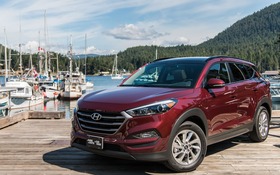2016 Hyundai Tucson: Definitely More Competitive

| Strong points |
|
|---|---|
| Weak points |
|
Hyundai has big plans for its new 2016 Tucson. In the past, the Tucson has certainly not been the most competitive offering in its segment, but the Korean automaker now has an assurance that it can compete in the market for compact SUVs, and as everybody knows, it is an intensely competitive market.
For example, Hyundai’s product planners asked the engineers to take the driving dynamics of the Volkswagen Tiguan as one of their targets.
The 2016 Tucson offers greater rigidity than its predecessors, and its all-wheel-drive system now incorporates computer-controlled braking of individual wheels to improve its cornering characteristics.
The compact SUV challenge
People will point out that in the compact SUV segment, the idea is not to produce a watered-down and bulked-up Porsche 911, but to offer a product that is progressive and youth-minded enough to attract the target clientele of young families and young couples without kids, but at the same time comfortable and refined enough to justify buying such a product in the first place.
In order to achieve success in such a market, Hyundai had to come up with a well-balanced product that is both progressive and refined. In a nutshell, that is what they have done.
Various versions
Can you have too many versions of the same vehicle? This is no idle question, particularly as the Tucson is offered to buyers in seven distinct versions.
Despite the multiplicity of Tucsons, you will have to start by choosing an engine. For 2016, there are two choices: the first is a 2.0-litre four producing 164 horsepower and 151 lb-ft of torque, matched to a 6-speed automatic. AWD is available as an option.
The second is a turbocharged 1.6-litre four producing 175 horsepower and 195 lb-ft that drives all four wheels through a dual-clutch 7-speed automatic.
After that, it is just a question of choosing the equipment you want. If you have to have a panoramic roof, a smart key, a heated steering wheel and a 10-speaker multimedia system, your Tucson with the 2.0-litre engine will set you back $33,099. If you go for the 1.6-litre turbo, and you want ventilated seats, chrome accents and other premium touches, the price goes up to $39,599, which makes the Tucson one of the most expensive vehicles in its segment. You can always settle for a more reasonable list of options.
Proof of the pudding
The first question you have to ask yourself is: “Which engine do I want?”, bearing in mind that the 1.6 litre turbo produces only 11 horsepower more than the naturally aspirated 2.0. The real difference is to be found in its much more impressive torque figure, and it is a difference you can definitely feel. As soon as you put your foot down, the turbo will push you back into your seat in a way that the 2.0 cannot match, and the dual-clutch transmission works beautifully.
So the answer is obvious, right? Not really, because the 2.0 offers similar performance in every other aspect of its work. In both cases, the power is only just adequate, particularly if the vehicle is heavily loaded, or climbing a steep grade.
In offering a turbo version of the Tucson, Hyundai could have tried a little harder, short of running the turbo engine on high-octane fuel.
Dynamically speaking, it must be said that the 2016 Tucson is a much more progressive ride. Without trying to out-Mazda the CX-5, it nevertheless handles better than the RAV4 or the CR-V. Using the Tiguan as its target was probably a good thing. The 200 horsepower available in the Tiguan should perhaps have served as an inspiration in choosing an engine for the Tucson.
A word of caution: the steering provides very little feedback, but many drivers won’t be bothered by this at all.
In other respects, the Tucson features excellent quality in soundproofing and interior comfort, and generally offers a high level of refinement.
Holding its own
At the launch, Hyundai claimed it had a Tucson that could go head-to-head with the Rogue, the CR-V and the RAV4. So can it?
Some complain that the styling is bland, but there are some family resemblances to the Genesis sedan. The interior is not the most beautiful in the industry, but when compared with other compact SUVs, the Tucson is equal to its peers.
In conclusion, it is hard to find much fault with the 2016 Tucson, which is in reality an excellent SUV quite capable of competing with the others.
Admittedly, the steering could be better, the Tucson-with-everything is too expensive, and the 1.6 litre engine could benefit from a little more power, but all these shortcomings are offset by the good features, including two transmissions that work faultlessly.
Hyundai should not expect to rest on its laurels now that the Tucson is competitive. Things can change quickly in the compact SUV segment.











